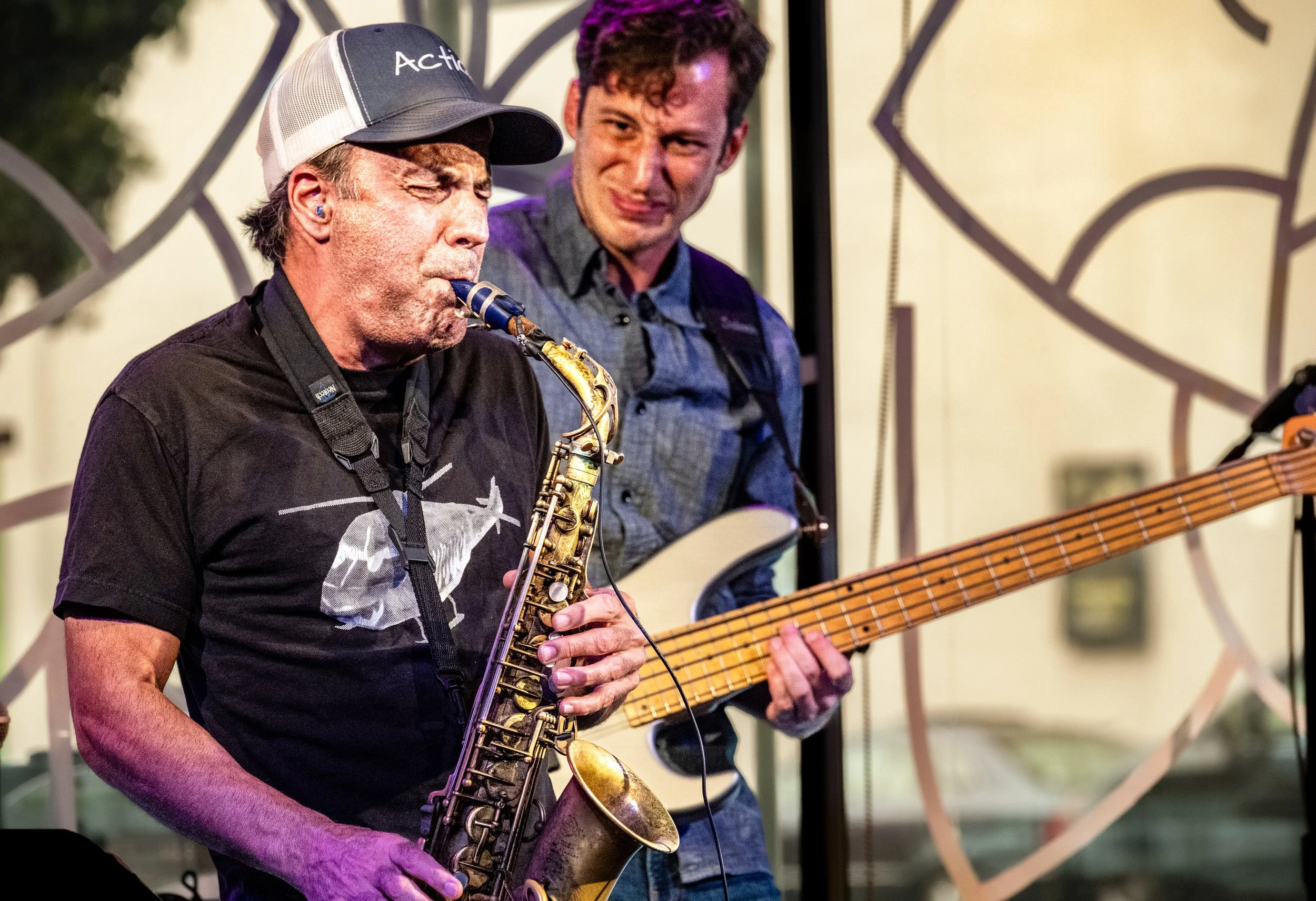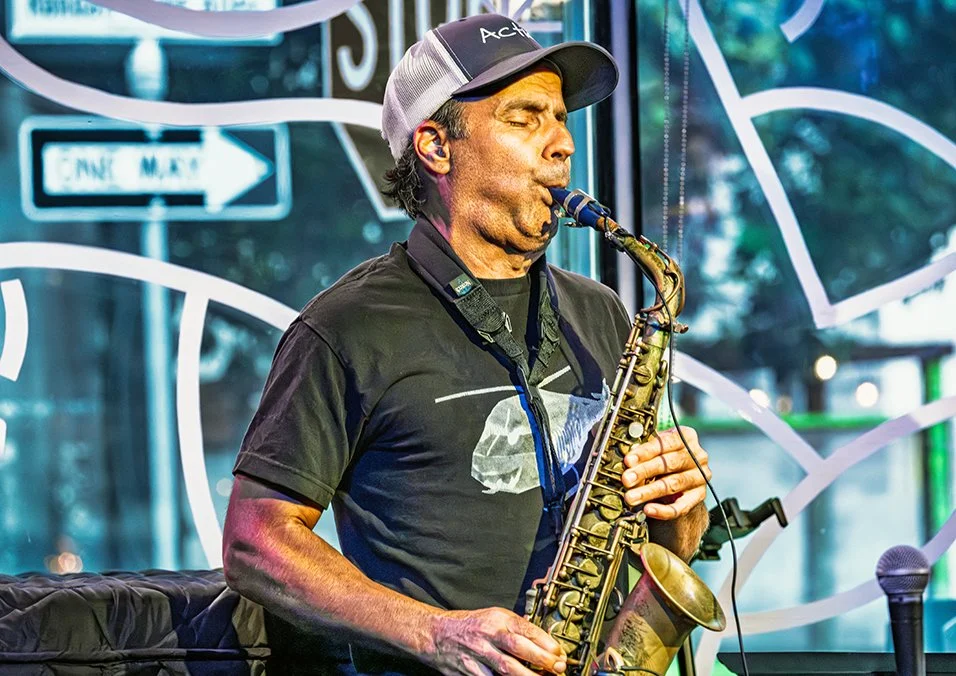David Binney Action Trio At Joe Henderson Lab
David Binney Action Trio
Joe Henderson Lab
San Francisco, California, USA
August 9, 2025
With its two glass walls—one facing busy Franklin Street—the Joe Henderson Lab at the SFJAZZ Center feels like an open studio. At 7 p.m., the sold-out David Binney Action Trio made the most of that intimacy: all 100 seats were filled with fans of electro-acoustic jazz blended with funk and rock, some holding LPs and CDs for signatures while passersby looked in. Heads began to nod as soon as drummer Louis Cole found a groove, and they hardly stopped.
Binney walked on smiling, a laptop perched on a small table within arm’s reach. “This is my first time playing here, which is amazing because half of my friends are in the SFJAZZ Collective, and like, I’ve just never been here,” he said. “I walked by it a few times. It’s nice to be inside.” He then made the room his workshop, opening with a five-minute untitled ambient improvisation that set a patient, expectant mood. Kneeling on one knee, he blew into the alto and manipulated harmonizing, looping, and delay effects by hand, shaping breath-weighted tones into conch-like overtones and airy reeds. The soundscape was not a prelude so much as a thesis: electronics as instrument, not garnish.
Without ceremony, the trio—Binney, Cole, and bassist Pera Krstajic—slipped into “For My Friends” from Action (2023). The groove was lean and warm, Krstajic riding a pliant line while Cole’s cymbal pattern danced around the backbeat. Binney’s alto entered like a flare, singing above the rhythm section and then folding back into it. The tune ended on a dime, a sudden stop that drew hoots and quick applause. More than once during the night, Binney reached to the laptop to trigger soft beds of pre-recorded vocals and synths, not to crowd the trio but to give contours to the live lines. The electronics widened the stage picture without blurring it—credit to the Lab’s custom system and the band’s restraint.
“Night Fall,” a Ralph Towner piece, arrived next in Binney’s arrangement and became a set centerpiece. Krstajic introduced a fuzzed, almost granular texture before settling into four-bar chords. Cole tightened his attack to a rat-a-tat figure, then opened the hi-hat so the rhythm breathed. Binney let the horn wait. When the melody finally arrived, it threaded through a haze of reverb that gave the alto a smoky edge, occasionally bending into a near-backwards smear. The trio escalated—cymbals crashing, bass running fingers up and down the neck, saxophone squeals clipped to sharp punctuation—then throttled back in unison. Listeners bobbed as if they’d been handed a metronome. The sudden finish earned a loud response and a few joyful shouts.
Binney’s book favors contrast, and the next swing came from the drummer’s corner. Midway through the 70-minute set, Cole took a solo feature that began with stacked vocal loops—soft, close-mic’d fragments that he harmonized in layers—before he grabbed a mini Roland keyboard, resting it on his lap to play a spare emotional piece. At the same time, Binney answered in gentle phrases on alto. The vignette was a reminder of Cole’s range and of the trio’s ethos: three strong voices, any of which might suddenly step forward without breaking the arc of the set.
From there, the band leaned into material that blurred categories without apology. “Birth” appeared twice, first as a compact jolt and later as a more extended read. The first pass emphasized motion—odd-meter figures snapping into place as if the floor had shifted half a step to the left. Cole worked short bursts on snare and toms while Krstajic carved through lines that split the difference between bass guitar and baritone melody. The reprise stretched and breathed, Binney moving between sustained tones and quick, needled runs at the electronics table, then standing to drive the theme home. It’s the kind of writing and arranging that rewards repeat listens; a second reading in a single set made the point.
The evening’s quietest moment belonged to Cole’s “Everytime,” from his 2018 album Time. He took the first verse almost in a whisper, a breathy delivery that set a fragile tone before bass and sax entered as soft shadows. The lyric—reflecting on what fades and what remains—hovered in the room. Binney resisted the temptation to oversing; his alto lines were slender and mournful, more commentary than solo. Krstajic’s touch stayed light until the final cadence, when a simple pivot on keys, a patient bass figure, and a wistful strand of alto landed together. They let the last chord linger in the Lab’s air before anyone clapped.
If the opener showed Binney’s command of texture, the closer showed his appetite for velocity. “Aliso” began with a false start (a glance at the stand, a few bars, and a stop) and then lifted off as all three players pounced on a fast, angular figure. Cole drove hard, kick drum locked to Krstajic’s walking line, while Binney toggled between the horn and a control surface, spitting short toots and then climbing in long arcs. The tune flirted with prog-rock’s jagged time shifts—more than once, the push and pull suggested King Crimson or Soft Machine—but it never lost the idiom. A brief drum break framed by a single, sustained alto note drew yelps; the final surge to the theme brought the room to its feet.
Throughout, the Action Trio delivered on the promise of its name. Binney’s alto remains one of the most immediately identifiable voices in contemporary jazz—bright, cutting, and capable of turning on a phrase from lyric to serrated. His writing favors sturdy themes that can withstand the rhythm, and his electro-acoustic palette is integrated enough to feel organic. Cole’s drumming, crisp and physical, kept the energy high without crowding the music; those over-ear headphones weren’t just for show, as he steered live loops and click-sensitive changes with ease. Krstajic anchored the band with a rounded, modern bass sound and a composer’s ear for harmony. When the groove needed grease, he supplied it. When the music needed a new center of gravity, he moved it.
“This is some stuff from a record that we did a couple of years ago called Action, some newer stuff, and improvise some stuff,” Binney told the audience early in the set. That understatement fit the night. The show balanced tunes and textures, design, and risk. The Lab’s urban backdrop—cars sliding past the windows, silhouettes pausing to look in—only heightened the sense that this music lives in the present tense.
For newcomers, the takeaway is simple: start with Action to hear where these pieces began, then find this band live. The records sketch the architecture; in a room like the Joe Henderson Lab, the trio lets you walk the halls. And if you happen to leave with a signed LP under your arm, you’ll have a good story about the evening you watched an alto saxophonist kneel to conjure a world, a drummer sing to build one, and a bassist smile as the last note dissolved into the bustling city outside.
Set List: untitled ambient improv; “For My Friends”; “Night Fall”; “Every Time”; “Birth”; “Aliso”.



